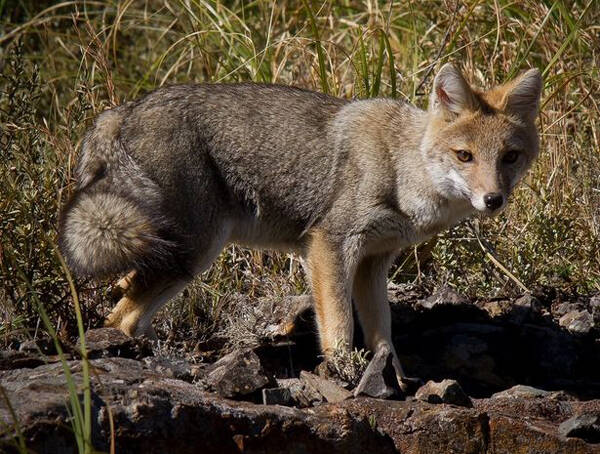Lycalopex gymnocercus
IUCN
LCBasic Information
Scientific classification
- name:Lycalopex gymnocercus
- Scientific Name:Lycalopex gymnocercus,Pampas Fox、Azara's Zorro,Pampas fox, Paraguayan fox, Paraguayan jackal
- Outline:Carnivora
- Family:Schizopoda Canidae Vulpes Pseudocelphus
Vital signs
- length:About 62 cm
- Weight:4.2-6.5kg
- lifetime:13
Feature
Gray fur, black spots on the snout, collects things, and plays dead
Distribution and Habitat
Distributed in Argentina, Bolivia, Brazil, Paraguay, Uruguay.
The river fox inhabits the pampas, hills, wastelands, ridges and deserts. They prefer plains with tall grass, mountains, streams or dune forests, occasionally entering forest areas.
Appearance
The river fox is a medium-sized fox that looks like a mountain fox, but is smaller and can be distinguished by the black muzzle. It weighs 4.2-6.5 kg and has an average length of 62 cm. The fur is gray with black markings on the muzzle. Their fur is short and dense, and the back and abdomen are gray. The head and neck are red, and the ears are triangular, broad and large, red on the outside and white on the inside. The tail is 34 cm long, and the thick tail has two black hairs, one on the upper side of the base of the tail and one on the tip of the tail. Males are 10% heavier than females. The fur of river foxes in the north is brighter.
It has a well-proportioned body, slender limbs, and toe-walking, which is conducive to fast running. The head and palate are pointed, the face is long, the nose tip is prominent, the ears are pointed and upright, the sense of smell is sensitive, and the hearing is well developed. The canine and carnassial teeth are well developed; the upper molars h
Details
The river fox (scientific name: Lycalopex gymnocercus), also known as Pampas Fox and Azara's Zorro in foreign languages, is a pseudo-fox native to the Pampas of South America, with three subspecies.

River foxes are solitary, living together only during the breeding season and when caring for their young. If threatened, they will play dead until the threat is gone. They are mainly nocturnal, but sometimes active during the day in inhabited areas. River foxes spend most of their time in grasslands hunting prey.
The river fox exhibits two particularly interesting behaviors. One is the well-known hobby of collecting, such as pieces of cloth, leather, and some household garbage abandoned by humans, which can often be found in river fox dens. The other is that when they feel threatened by people approaching and have no time to run, they will crawl on the ground, close their eyes, and lie upright pretending to be dead until the perceived threat leaves. They are mainly active at night and often visit the outskirts of villages and towns with sparse populations.
The river fox is an omnivore, but mainly eats meat. About 75% of the diet is composed of rodents, lagomorphs (rabbits, hares and pikas), and birds. These foxes also eat frogs and lizards. Plant matter includes fruits and sugar cane stalks. Even poaching poultry.
The river fox is usually solitary, and appears in pairs during the breeding season. It is monogamous. The breeding season is from July to October each year, and pregnant females hide in dens at the bottom of trees or in the jungle. The gestation period is 55-60 days, and each litter has 3-5 pups. The pups are almost black at birth, but gradually lighten as they grow. The male fox brings food to the pups while the mother cares for them. At 2-3 months old, they will hunt with their parents. The average lifespan is 13 years.
The main threat to the river fox is that humans hunt them for their fur, and also kill them to protect livestock. Most species have suffered huge habitat changes in their living space and range. For example, in the Pampas, a large proportion of the species' distribution range has been affected by extensive beef cattle breeding and agricultural cultivation. Only about 0.1% of its original range of about 500 square kilometers remains. However, due to the adaptability of the species, the Pampas Fox can withstand the loss and degradation of its natural habitat, as well as hunting pressure. Since there are no studies on the impact of rural ecosystems on population dynamics, caution is warranted, as the sum of these threats will eventually contribute to the depletion of the river fox population. Hunting pressure has led to a decline in the province of Tucumán and Salta in northwestern Argentina. The fur trade of the river fox is prohibited.
Listed in the 2012 IUCN Red List of Threatened Species ver 3.1 - Least Concern (LC).
Protect wildlife and eliminate bushmeat.
Maintaining ecological balance is everyone's responsibility!








